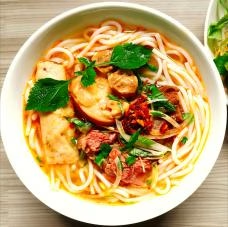Vietnamese specialty, pho, boasts a translucent appearance and a chewy texture. Made from rice paste, traditional Vietnamese pho is prepared by mixing rice into a paste, steaming the paste until it forms rice paper, and finally cutting the noodles into strips.
To imitate authentic Vietnamese pho noodles, simply prepare the rice noodles and other ingredients, along with a few common kitchen utensils. Follow these steps to create your own traditional Vietnamese handmade pho noodles.
How to Make Raw Pho Noodles
Difficulty: Medium
Preparation Time: 10 minutes
Cooking Time: 30 minutes
Yield: Approximately 454 grams
Traditional pho noodles are made by soaking raw rice in water overnight to soften it, then grinding the rice and mixing it with tapioca starch to create a white paste.
Spread a cloth over the steamer and use a spoon to scoop the rice paste onto the cloth and spread it evenly. After heating for a few minutes, the rice paste will transform into a fine, white sheet. Use a long bamboo stick to lift the rice paper and place it on a bamboo mat to dry. Once the rice paper is no longer sticky, stack the sheets and cut them into pho noodles.
Unless you have a dedicated rice paper steamer at home, it’s difficult to replicate the traditional recipe. Local markets in Vietnam do sell such steamers, which are typically used to make Vietnamese-style steamed rice rolls (bánh cuốn). You can make pho noodles at home using simple kitchen utensils by following the instructions below.
Ingredients
1 cup (158g) rice flour
1 cup (120g) tapioca starch
2 cups (475ml) water
1/2 teaspoon salt
2 teaspoons vegetable oil
Instructions
- Combine all ingredients in a large bowl, mix well, and let sit for 1-2 hours.
- Place a plate on a steaming rack and steam in the steamer for 1-2 minutes to warm the plate.
- Stir the rice batter and scoop just enough onto the plate to cover the bottom. Steam the rice paper for 4-5 minutes, until it is firm and translucent.
- Run a spatula or scraper around the edges of the rice paper and carefully remove it from the pan. Set aside to cool. Repeat this process for the remaining rice paper.
- Stack two or three cooled rice paper sheets together and cut into rice noodle strips, adjusting the width to your preference.
How to Cook Dried Rice Noodles
Difficulty: Easy
Preparation Time: 10 minutes
Cooking Time: 10 minutes
Yields: 1.1 kg cooked rice noodle strips
If you can’t make your own rice noodles or can’t buy raw rice noodles, you can also use dried rice noodles. This cooking method can be used to cook many types of dried rice noodles, including rice noodles (bánh phỏ), rice noodles (bủn), transparent rice noodles (hủ tiếu dai), and Quang Nam noodles (mì Quảng). However, the cooking method for rice noodles (miến) is different; please follow the instructions on the package.
Ingredients
12 cups (2.5 liters) of water
1 tablespoon (15 ml) of vinegar
1 teaspoon of vegetable oil
500 grams of packaged dried vermicelli noodles
Instructions
- Bring water to a boil in a large, flat pot. Add the vinegar and vegetable oil. (The vinegar will help the noodles set, and the oil will prevent them from sticking.)
- Add the dried vermicelli noodles and boil for 5-10 minutes, following the package instructions. Remove the noodles when they are soft but still chewy.
- Drain the hot water and rinse them under cold water to remove any starch from the noodles and stop heating.
- Rinse again with hot water to dehydrate the noodles and reduce clumping. (Rinsing with hot water this time helps the moisture evaporate faster, keeping the vermicelli dry and firm. Skipping this step may cause the vermicelli to become soggy and mushy, clumping together.)
Cooking Tips
Soaking the dried vermicelli in water for 5 minutes before cooking can help shorten the cooking time.
Placing a bowl upside down in a strainer before pouring the vermicelli out of the pot can help reduce clumping. The round shape of the bowl makes the vermicelli fluffier and easier to separate, preventing it from clumping together.


Leave a Reply